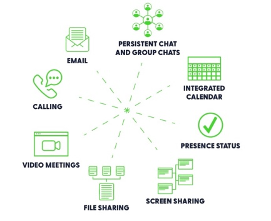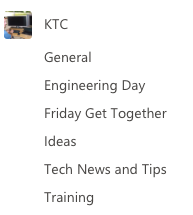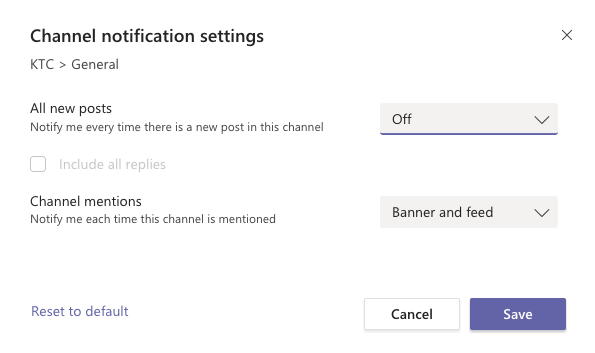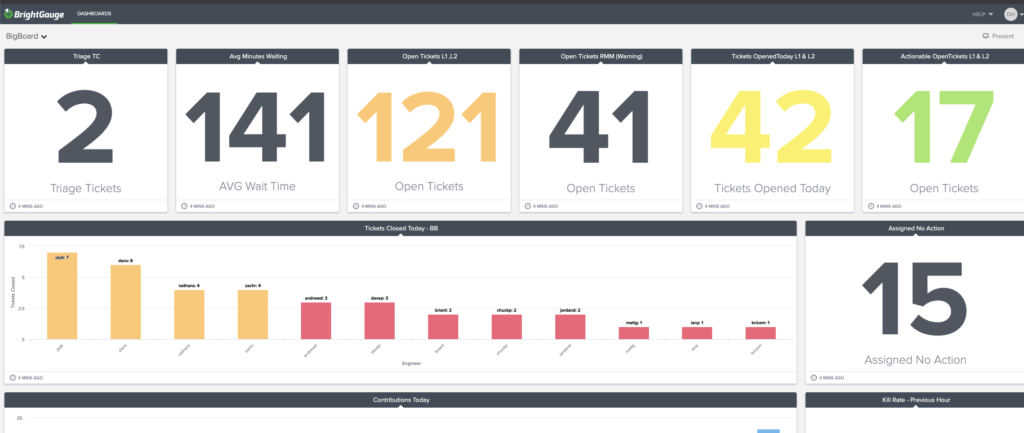
How should you manage a remote workforce, and what differs from “just managing?” We shared some helpful info on remote work, including Ten Tips to Work Remotely, How to Get Connected to Systems and Teams, and How should IT respond to the Covid-19 Virus? These articles should help workers and IT smoothly and securely move to a remote work setting, but this creates the question, “How do I manage a remote workforce?” The principles of proper management are generally known, so a lot of this is the things we as managers and leaders should do. But the disconnected nature of remote workers creates new challenges which is the focus here: how can we apply sound management principles to a remote workforce?
In this article, we will tell you how to assess your team and technology, set expectations, communicate effectively, and manage successfully.
Assessing your Ability to Manage a Remote Workforce
The first step is to make sure you evaluate and plan the team and technology for moving to remote work. In response to Covid-19, we all had to move without a lot of choices quickly, but the exercise is essential to maximize success. There are several things to consider.
Determine which roles can / need to work from home
Not all employees will need to work from home or can. A manufacturing production or maintenance employee will still need to be onsite for operations, along with some accounting personnel to an extent (AR and AP), and some others. Review your organizational chart for those who can work remotely.
Review your Technology with your IT Team or Provider
There are a lot of moving technology parts, and you must provide three things at a minimum: Security, Reliability, and Ease of Use. You must consider what devices/clients can access your systems. Will a Virtual Private Network (VPN) be required? Is a Remote Desktop or Terminal Server needed? What is the minimum connectivity parameters for remote network connections (e.g., internet speed)? Keystone can help you evaluate all of this.
Communication capabilities are another area to assess. How will your team communicate remotely? Is there a secure video conference tool you can use? Do you have access to collaboration tools, like Microsoft Teams or Slack? Will users have access to the corporate phone system either by taking a device home or using a softphone?
What must be purchased to provide access? Typical costs include new client devices like laptops, VPN licenses, and headsets. You should create a budget for any services needed to configure this.
While you are doing this, include a security check at every step. You are not immune to a security breach; in fact you are more likely to have one: 36% of organizations have experienced a security incident because of a remote, insecure worker. We recommend that a person with security skills and mindset review each decision and that you also do a Penetration and Vulnerability test, along with regular phishing test campaigns and end-user training.
Check and update your business continuity plan. These changes may expose new holes, and any differences should always be evaluated and updated.
Other Concerns to Assess
Next, do you have a written policy for employees or users to sign that indicates the terms and use of remote access? Does it protect you from personal devices, or costs for using their internet, etc.? Keystone has a sample policy for this available upon request.
In a related note, consider a legal review of the ability and need to work remotely. Will any issues be raised because FLSA non-exempt employees may work odd or additional hours? Are there any other legal or employment issues that may arise? We suggest consulting with your legal counsel, particularly those in HR law.
Expectations When You Manage a Remote Workforce
With change comes new ways for people to think about their work. You must set expectations for productivity, availability, and communications.
First, this is where we remind ourselves that sound management principles are always good management principles. Good managers set expectations. We do not leave it to the masses to decide what we accomplish, or when, or how. It is incumbent to still manage the remote workforce to objectives and processes. You will imprint your personality and approach, but every good manager considers at the very least productivity and communications, and in this case, availability.
What are your expectations for productivity? Can, and do you expect the same production from a remote employee, as you may see when they work onsite? You probably should at least for a start, and often you may see better productivity. There are new distractions by working from home or elsewhere, but if an employee follows our guidelines for Ten Tips to Work Remotely, they will increase productivity by 5% or more. Be clear about what you expect in terms of productivity. It is unlikely the metrics you use will change but consider the target goals.
Next, is communication – how and when do you expect communications? Is there a regular check-in call? Do they record activity in tickets or order records, etc.? Set a minimum period for emails to be answered. If you call, how should they respond, drop everything and answer, or call back? Be clear, while acknowledging the new normal of remote work.
And finally, availability, what hours are they expected to be available? Are you shifting hours to account for family needs, or drive time, or new customer needs? And remember the legal aspect mentioned above, FLSA laws do not change for remote workers. Treat your employees as human and be clear on availability.
Communication
While listed above, communication deserves its area; this is the crux with remote workers: you can no longer assume you will run into them at the water cooler or see them in the hallway or staff meeting.
Be Regular with the Team
The first principle is to communicate regularly. You may hold quick daily huddle calls for a while to deliver the latest status, check-ins, etc. A quick call at the start of a shift will set expectations, communicate issues, and allow for team connectivity. Our service manager, Bill Mastrobuono, holds a call with his remote team every morning. In the call, they go around on an informal basis and do a check-in. They discuss any client issues and make each other aware of any projects that may affect support functions, and then do cross communication from other meetings. Finally, they discuss any change in the process or tools. The call usually takes 15-30 minutes.
And our squad leads meet with their team every Friday.
Be Regular with People
I have found, deliberate, planned phone calls from leaders go a long way to helping to care for and connect to employees. They also get to share what they are working on and how they are doing. Regular communication is essential, and frankly, it may be easier to do than in the office. When I say deliberate and planned, I do not mean a scheduled call, but a block of time and list of people to call and track the calls to make sure no one goes missed for too long. When on the call, I casually check in on the following items:
- How are they doing? Personally: Self, family, health, etc.
- How is work progressing?
- Are there any teammates struggling that we can help?
- Are any customers struggling that we can do better?
I have also found that note cards in the mail are an excellent way to connect tangibly. We can’t see each other, so seeing a card with some quick notes can be a more intimate and physical way to interact.
Communication Tools
We recommend using a convenient communication tool like Microsoft Teams, Slack, or Basecamp. These tools are multifaceted. Microsoft Teams allows 1:1 chat, group chats, entire communication forums, voice chats, video chats, and full meetings with a team with most of these at once. It also provides file storage and sharing capabilities and screen sharing. It is very effective at bringing people together and making them productive. Teams is included in most Office 365 subscriptions, so you may already be licensed for it. Slack has similar capabilities. Here are some functions Teams or Slack provides.

When you move into these tools, establish their expected use. What is the information architecture of the setup? Where does ongoing work go? In a chat instead of a channel? Will email still be used, and if so, for what? Organizations for years have complained about too much email; this is an excellent chance to break out of that.
Teams has two primary ways to have group capabilities: Teams, and then under teams are channels. At Keystone we have a KTC channel, a Huddle Channel (for weekly project huddle calls), Health and Wellness Channel, Support Team, and Client team. Under the General Team, we have channels for various needs, including General, Engineering Day, Ideas, Tech News and Tips, and Training.
One channel we recommend is the water cooler channel. At Keystone, that is the “General” channel under KTC. It has naturally become a catch-all for pictures of kids, funny videos, world news, and general updates. When a team works remotely, they can lose a sense of each other; the water cooler conversations have always driven cross-communication. In fact, Steve Jobs designed the Pixar headquarters with central bathrooms so employees would bump into each other. A remote workforce won’t get that, but the water cooler channel can help. It also causes people to visit the communication system more often, and by looking for some happiness of a funny video, they even stumble across information needed for today’s work.
Allow and train users in managing notifications, so there is not a constant pop up in the corner of the screen for irrelevant (to them) notifications.

Video Conferencing Rules
We recommend you establish expected norms for video conferencing. Some suggested requirements:
- Join five minutes early to avoid delays due to issues with technology
- Everyone should focus on the meeting: do not answer email, etc.
- Focus on voice, not video – some people think you need an expensive HD webcam, but that just generates more traffic and can affect the voice transmission. Others in the conference will be impacted more by a weak, stuttered voice than by poor video.
- Watch background and lighting. Have a non-distracting background. Most services now allow a custom background, where you can upload your photo, and provide stock images of a landscape, etc. Use these, or just make sure the background is not overly cluttered. Also, make sure the background lighting is not so bright that it creates glare, and you look like an angel descending from the sun. If you have some Phillips hue lights, you can customize color and brightness. And finally, make sure the light on your face will present an even tone and level.
- Teams vs. Zoom – We use Microsoft Teams at Keystone for most communications. It is easy to start a chat with someone, and smoothly move to a video call with screen sharing, and then quickly ask additional people to join. But it is limited to seeing four people at a time on the main gallery view (they have said they are increasing this to 9). We have found Zoom works much better for a high number of participants, such as an entire company meeting. The quality is better, and you can see up to 25 people on screen at once and scroll to see more.
Use a Higher Default Mode of Communication
Remote workers need a higher level of connectivity to replace face to face. So, if you previously used email, go to a phone call; if you called on the phone, go to a video chat. Be personal and close.
Other Helpful Tips for Communications
We have found the following to help keep everybody together and communicate professionally and personally.
- Virtual Happy Hours – Every Friday at 4:30, we hold a virtual happy hour. It has been a lot of fun, and for some, the only time they may see some others on the team. Each week we have a different host, and lately, they have been coming up with fun themes. We use Zoom for this, as mentioned above.
- Company Staff Meetings – Keystone has for over a decade held an all-company meeting on the first Friday of the month, and then set the rest of the day aside for fun (with a small staff still on support). It is part of our culture and essential to us. We now do the monthly staff meeting on Zoom, with the same agenda and “feel.”
- Affirm success publicly – People may not see what others are doing and hearing about progress, which creates a vacuum that can affect the perception of the times, the company, and how we are doing. Take some time to send out communication of what is going great, personal and professional success, and big wins.
Managing
And now we get to the actual management. Until now, we set a framework for assessing your organization and team, setting expectations, and establishing good communications. If everything was done well to this point, your ability to manage a remote workforce should be smoother. You will note that a lot of the ideas below are just good management techniques, but with some nuances for the remote team.
Manage Yourself First
If you manage others, you must first look at yourself. Set a high standard, keep your promises, and be consistent. Consistency is key here; in a world, with many unknowns, a consistent manager can be a rock. People will drift from each other and best practices, so set the expectations, and model and require them.
Know the Team is #1
You probably spent a lot of time building the team. Defining positions and relationships between them, recruiting, onboarding and training, developing, and coalescing. Do your best not to lose anybody due to extreme circumstances. Remote work may not work for all, and you will find that out, but be persistent with reiterating expectations and communicating to support them as individuals and reinforce the expectations. It is expensive and potentially damaging to lives to replace people.
Also, know your team. At Keystone, we use several tools to assess our team and position them for success, starting during the recruiting process. We begin with conversations that are real and do not let things just slide by. If there is a concern, it should be said. We add assessments that tell us a lot about the individual. We have four primary tools:
- StrengthsFinder (now called CliftonStrengths) – a great tool to understand where a person will shine on the team.
- PXT Select – We use this to assess people for how they fit a job. In the case of remote work, one factor it reports is Independence – how much managing will the person need or want? People with low independence should be checked on more often.
- Predictive Index (PI) – this provides a report of the way a person will behave in life, and the job. We use the PI Behavioral assessment, which looks at a person’s drives and needs, ultimately generating their work habits. It is cognitive (how a person thinks). We also cross-check this against other team members.
- Kolbe A – This tells us how a person works (conative). We are a team of FactFinders, which is typical for an IT firm 😊.
Simplify
If you were playing a football game in a snowstorm, “you would not focus on long bombs, you would focus on not fumbling the ball.” That is somewhat the way you need to think when managing a remote team. We are not saying you will not achieve phenomenal results, you can, but you need to simplify the process.
A few years ago, we did an exercise with our team where we had everybody take a sheet of paper, and closed their eyes. I then gave instructions like:
- “fold the paper in half.”
- “fold it again.”
- “tear a corner off.”
- “Unfold it.”
- “fold it into thirds.”
- “tear a corner off.”
And so on. We opened our eyes, and everybody had a very different result. This told us that simple, clear, and complete instructions were essential when you can’t see someone, like a user or a co-worker.
It needs to be simpler than face to face requirements. Simplify everything.
Plan the long, manage the short
Plan for monthly and weekly objectives and set accomplishment goals. Then break it down into weekly segments. Then weekly break it down into daily parts for that week.
Each month, and each week, ask yourself, “What are the big three we need to accomplish in this period?” Then manage daily, what three things did we accomplish to the goals?
Watch for everybody being coordinated. With disconnection comes disconnection from others and what they are doing, so make sure work is not duplicated or slipping through the cracks. Track assignments and expect communication on results.
Manage to Results
In remote work, less than being together, you cannot manage by feel; just walking through an area and seeing machines humming will not be possible. You must establish a scoreboard. What gets measured gets done. Determine the key drivers of success in your business, the Key Performance Indicators (KPIs), and leading and lagging indicators. Measure them and publish the measures. At Keystone, we have systems to do this, and when in the office, we can glance at multiple monitors prominently displayed, but the beauty of our systems is that I can pull them up on my web browser and see where we are.

Once you have a reporting system in place, discuss individual performance issues individually. Consider the following in these discussions.
- Understand bad days happen. but low performance is not the new normal
- Manage with empathy
- People are adjusting, and their family is reorienting, etc.
- Each person is an individual, with individual needs and challenges
By establishing this approach, and managing to results, it should help you avoid being a helicopter manager – hovering over the team, which is impossible anyway.
As all great leaders expect great results.
Expect Better Results
One of the biggest questions about managing remote workers is, “can I expect the same results?” There is a perception that people will waste time. And here is the secret: if you have done everything described to this point, you can expect better results! Here is the fact: 77% of Remote Workers report better results.
The usual distractions are gone, and if you have the right team aligned to the right goals, and managed well, they will perform better. We have seen this at Keystone, where our team is more effective and more efficient.
Survey the Team
With new changes comes an opportunity to discover what is going well. There are often in normal management flows where a chance to change comes along but following the status quo will squander it. But a situation like Covid-19 forces changes and is a great time to see what works better. You must get a gauge on how the team is generally doing. We suggest two ways to do this:
- Track engagement – We use OfficeVibe and have for over a year, it has shown us how things have shifted as we moved to remote work. We have seen our engagement and personal satisfaction score rise in this remote work period.
- Survey how people are doing through the change. Discover what they think works better and cross-check that against KPIs. Should long term changes be made to maximize efficiency, effectiveness, and employee engagement?
Summary
We hope you found this helpful in managing a remote workforce. Do not miss the opportunity to improve the effectiveness of your team and enhance their satisfaction through this. We have shared tips to assess your organization and group, set expectations, establishing good communications, and managing performance.
Do you want to better support and manage your remote workforce? Contact us at Info@KeystoneCorp.com to see how we can help you with this.




